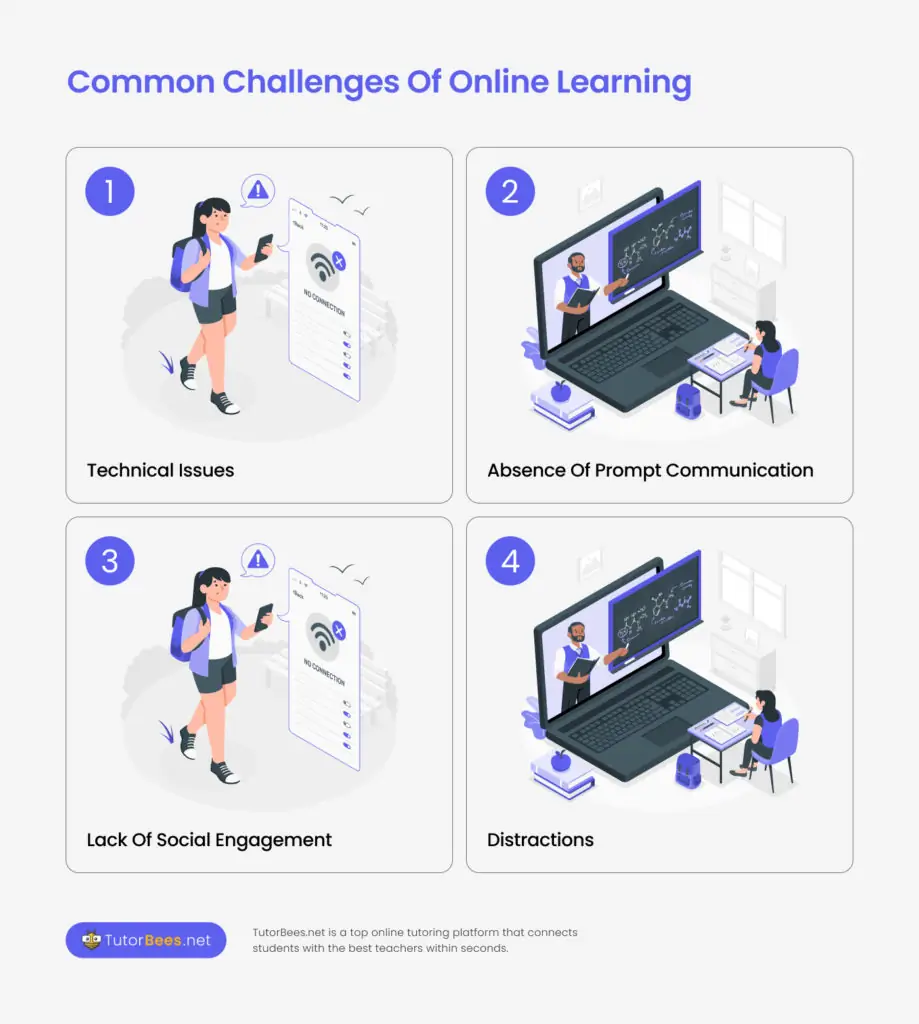The onslaught of the COVID-19 pandemic also spelled repercussions for the education sector, and national governments are encouraging education institutes to adopt alternative means of education. Consequently, education institutes worldwide started shifting to online learning for assistance, culminating in the tremendous growth of online education platforms.
According to research, the global E-Learning Market will grow to $457.8 billion by 2026. [1]
As millions of students are acclimatizing themselves to this new and fruitful approach, it still presents some challenges, such as maintaining students’ engagement in an online learning environment.
We highlight some of the most common challenges and present remedies to tackle them.
Common Challenges of Online Learning

Technical Issues
Although we are enjoying faster internet speeds and easy access to Wi-Fi, despite that, technical issues are bound to arise, such as your internet speeds going down or Wi-Fi completely shutting down. Not only that, your desktop, laptop, tablet, or smartphone could also malfunction. It could prove to be exasperating and ruin your online learning experience.
Absence Of Prompt Communication
In virtual classrooms, the communication between a student and teacher is asynchronous, unlike in conventional classrooms where a teacher is present in person. Such situations can catalyze confusion and hinder a seamless education experience.
Lack Of Social Engagement
The social aspect also influences the decision-making process for most students when it comes to e-learning. Most students prefer a traditional class setting over an online class, mainly due to the physical interaction cultivating deeper bonds between peers. Lack of physical interaction with your teacher and peers often demoralizes students and plunges them into monotony.
Distractions
Whether you live with family or alone, have a pet, or your doorbell ringing when no one else is around to answer. Distractions that prove to be highly vexing can cause you to lose focus - efficiently inhibit an engaging online education experience.

Suggested Read: Top 7 Things your Kid Might be Doing That Kill Brain Cells
How To Encourage Student Engagement In Online Learning?
Early Planning
Students need to plan their schedules to prove highly effective and counter those bothersome distractions. Prefer timings where you will encounter minimal or no distractions and find out also look for a serene and isolated spot in your home.
To confront the challenges of student engagement, education experts can implement the following strategies to make online engrossing and gratifying.
Smooth Communication
If there comes the point where the communication between you and your teacher is inconsistent and becomes vague, then do not hesitate to ask questions and clarify from your teacher. Likewise, you can also directly phone your teacher if online communication is still not seamless.
Congenial Behavior
Teachers should present themselves as cordial and not intimidating to students. Teachers need to know their students, therefore always commence the first class by asking students for their introduction. Teachers can also inform their students about the best method of instant communication, host virtual office hours, and provide prompt and interactive feedback on student work.

Also Read: Five Qualities of a Good Teacher – Find Out What They Are!
Social Relations with Peers
Critical and cognizant discussions through discussion forums and blogs and assigning team projects to students can enhance peer engagement. Moreover, promoting social media to forge peer connections can also boost social engagement with peers.
Inform Your Teachers
If students encounter a technical issue such as slow internet or device malfunction, you can inform your teachers, who will assist by sharing recorded sessions.
Stress Accountability And Timely Feedback
Students should be scrutinized and held accountable for their participation and work. In addition to scrutiny and accountability, teachers should also provide swift, comprehensive feedback and positive critique to engage students with online learning.
Create Gripping Formats
Teachers should create interactive and structured lectures for students with lurid colors and animations for stimulating interactive infographics presentations and building assessments to hold their students’ attention. Moreover also develop a short introduction to courses, modules, and essential concepts.
Course Flexibility
Online courses should also offer students flexibility and accessibility. Students should be able to access the course from any device such as smartphone, tablet, laptop, or desktop at any location or any time.
Conclusion
The COVID-19 pandemic has ushered unprecedented times for all of us, including teachers and students. Consequently, teachers should try to bring the same boisterousness and interaction from the physical classroom to an online classroom. And as the famous Japanese scholar, Kakuzo Okakaura said, “The art of life is a constant readjustment to our surroundings.” - Students should conform themselves to the new environment and reap the rewards in the form of a practical and rewarding learning experience.
Also Read:
References:
[1] “Global E-Learning Market to Reach $457.8 Billion by 2026” - Global News Wire



